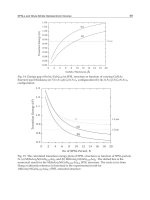Composite Materials Design and Applications Part 3 doc
Bạn đang xem bản rút gọn của tài liệu. Xem và tải ngay bản đầy đủ của tài liệu tại đây (1.03 MB, 19 trang )
the fiber volume fraction V
f
varies, and as a result, the dimensional characteristics
of the piece (thickness) also vary. To deal with this problem, one may want to
evaluate by test the optimal moment for the application of pressure, by the
measurement of the flexural rigidity of a specimen as a function of time of
fabrication (see Figure 3.24).
Figure 3.22 Tensile Test
Figure 3.23 Short Beam Shear Test
Figure 3.24 Variation In Stiffness During Curing
TX846_Frame_C03 Page 52 Monday, November 18, 2002 12:05 PM
© 2003 by CRC Press LLC
4
SANDWICH STRUCTURES
Sandwich structures occupy a large proportion of composite materials design.
They appear in almost all applications. Historically they were the first light and
high-performance structures.
1
In the majority of cases, one has to design them
for a specific purpose. Sandwich structures usually appear in industry as semi-
finished products. In this chapter we will discuss the principal properties of
sandwich structures.
4.1 WHAT IS A SANDWICH STRUCTURE?
A sandwich structure results from the assembly by bonding—or welding—of two
thin facings or skins on a lighter core that is used to keep the two skins separated
(see Figure 4.1).
Their properties are astonishing. They have
Ⅲ
Very light weight.
As a comparison, the mass per unit area of the dome
of the Saint Peter’s Basilica in Rome (45 meter diameter) is 2,600 kg/m
2
,
whereas the mass per surface area of the same dome made of steel/
polyurethane foam sandwich (Hanover) is only 33 kg/m
2
.
Ⅲ
Very high flexural rigidity.
Separation of the surface skins increases
flexural rigidity.
Ⅲ
Excellent thermal insulation characteristics.
However, be careful:
Ⅲ
Sandwich materials are not dampening (no acoustic insulation).
Ⅲ
Fire resistance is not good for certain core types.
Ⅲ
The risk of
buckling
is greater than for classical structures.
The facing materials are diverse, and the core materials are as light as possible.
One can denote couples of compatible materials to form the sandwich (see
Figure 4.2).
Be careful: Polyester resins attack polystyrene foams.
1
See Section 7.1.
TX846_Frame_C04 Page 53 Monday, November 18, 2002 12:07 PM
© 2003 by CRC Press LLC
To evaluate
t
and
s
, one makes the following simplifications:
Ⅲ
The normal stresses are assumed to occur in the facings only, and they
are uniform across the thickness of the facings.
Ⅲ
The shear stresses are assumed to occur in the core only, and they are
uniform in the core.
3
One then obtains immediately the expressions for
t
and
s
for a beam of
unit
width
and thin facings shown in Figure 4.4.
4.2.2 Displacements
In the following example, the displacement
D
is determined for a sandwich beam
subjected to bending as a consequence of
Ⅲ
Deformation due to normal stresses
s
and
Ⅲ
Deformation created by shear stresses
t
(see Figure 4.5).
Figure 4.3
Bending Representation
Figure 4.4
Stresses in Sandwich Structure
3
See Section 17.7.2 and the Applications 18.2.1 and 18.3.5 for a better approach.
TX846_Frame_C04 Page 55 Monday, November 18, 2002 12:07 PM
© 2003 by CRC Press LLC
where
The end displacement D can be written as
Then for an applied load of 1 Newton
Remark: Part of the displacement D due to shear appears to be higher than that
due to bending, whereas in the case of classical homogeneous beams, the shear
displacement is very small and usually neglected. Thus, this is a specific property
of sandwich structures that strongly influences the estimation of the bending
displacements.
4.3 A FEW SPECIAL ASPECTS
4.3.1 Comparison of Mass Based on Equivalent Flexural Rigidity (EI)
Figure 4.7 allows the comparison of different sandwich structures having the same
flexural rigidity ·EI Ò. Following the discussion in the previous section, this accounts
for only a part of the total flexural deformation.
Figure 4.6 Cantilever Beam
EI·Ò 475 10
2
;¥
GS·Ò
k
650 10
2
¥==
D
W∂
F∂
=
D 0.7 10
2–
mm/N 1.54 10
2–
mm/N¥+¥=
Flexure Shear
TX846_Frame_C04 Page 57 Monday, November 18, 2002 12:07 PM
© 2003 by CRC Press LLC
4.3.2.2 Local Buckling of the Facings
The facings are subject to buckling due to the low stiffness of the core. Depending
on the type of loading, one can find the modes of deformation as shown in
Figure 4.9.
The critical compression stress is given in the equation below where
n
c
is the
Poisson coefficient of the core.
The critical load to cause local damage by local buckling of a facing and the
types of damage are shown in Figure 4.10.
4.3.3 Other Types of Damage
Local crushing: This is the crushing of the core material at the location of the
load application (see figure below).
Figure 4.9 Local Buckling of Facings
Figure 4.10 Damage by Local Buckling
s
cr
aE
p
E
c
2
¥()
1/3
¥=
with
a 3123 v
c
–()
2
1 v
c
+()
2
{}
1– /3
=
TX846_Frame_C04 Page 59 Monday, November 18, 2002 12:07 PM
© 2003 by CRC Press LLC
Compression rupture: In this case (see figure below), note that the weak com-
pression resistance of Kevlar fibers
7
leads to a compression strength about two
times less than for sandwich panels made using glass fibers.
4.4 FABRICATION AND DESIGN PROBLEMS
4.4.1 Honeycomb: An Example of Core Material
These well-known materials are made of hexagonal cells that are regularly spaced.
Such geometry can be obtained using a technique that is relatively simple. Many
thin sheets are partially bonded. Starting from stacked bonded sheets, they are
expanded as shown in Figure 4.11.
The honeycomb material can be metal (light alloy, steel) or nonmetal (carton
impregnated with phenolic resin, polyamide sheets, or impregnated glass fabrics).
Metallic honeycombs are less expensive and more resistant. Nonmetallic hon-
eycombs are not sensitive to corrosion and are good thermal insulators. The
following table shows the mechanical and geometric characteristics of a few
current honeycombs, using the notations of Figure 4.11.
7
See Section 3.3.3.
Table 4.1 Properties of Some Honeycomb
Bonded Sheets of
Polyamide: Nomex
a
Light Alloy
AG3
Light Alloy
2024
Dia. (D): inscribed
circle (mm)
6; 8; 12 4 6
Thickness e (mm) 0.05 0.04
Specific mass (kg/m
3
)64 8046
Shear strength
t
xz rup
(MPa)
1.7 3.2 1.5
Shear modulus:
G
xz
(MPa) #
1.5 G
mat
(e/D)
58 520 280
Shear strength
t
yz rup
(MPa)
0.85 2 0.9
Shear modulus: G
yz
(MPa)
24 250 140
Compression strength:
s
z rup
(MPa)
2.8 4.4 2
a
Nomex® is a product of Du Pont de Nemours.
TX846_Frame_C04 Page 60 Monday, November 18, 2002 12:07 PM
© 2003 by CRC Press LLC
The processing can be facilitated using the method of overexpansion which
modifies the configuration of the cells as shown in Figure 4.14.
At limit of curvature, R is the radius of the contour, and e is the thickness
of the sheets which consitute the honeycombs (see Figure 4.15). Nomex honey-
combs (sheets of bonded polyamide) must be processed at high temperature. The
schematic for the processing of a structural part of sandwich honeycomb is as in
Figure 4.16. For moderate loadings (for example, bulkheads), it is possible to fold
a sandwich panel following the schematic in Figure 4.17.
Figure 4.14 Over-Expansion of Honeycomb
Figure 4.15 Curvature of Honeycomb
Figure 4.16 Processing of a Sandwich Piece of a Structural Part
TX846_Frame_C04 Page 62 Monday, November 18, 2002 12:07 PM
© 2003 by CRC Press LLC
When a composite structure (for example, a reservoir under pressure) is
subjected to loading, many microcracks can occur within the piece. Microcracking
in the resin, fiber fracture, and disbond between fiber and matrix can exist even
within the admissible loading range. These ruptures create acoustic waves that
propagate to the surface of the piece. They can be detected and analyzed using
acoustic emission sensors (see Figure 4.22).
The number of peaks as well as the duration and the amplitude of the signal
can be used to indicate the integrity of the piece. In addition, the accumulated
number of peaks may be used to predict the fracture of the piece (i.e., the change
of slope of the curve in Figure 4.23).
Figure 4.19 Some Links for Sandwich Structures
Figure 4.20 Honeycomb Repair
TX846_Frame_C04 Page 64 Monday, November 18, 2002 12:07 PM
© 2003 by CRC Press LLC
Figure 4.21 Principal Nondestructive Testing Methods
TX846_Frame_C04 Page 65 Monday, November 18, 2002 12:07 PM
© 2003 by CRC Press LLC
Figure 4.21 (Continued).
TX846_Frame_C04 Page 66 Monday, November 18, 2002 12:07 PM
© 2003 by CRC Press LLC
5
CONCEPTION AND DESIGN
A different paradigm:
As every mechanical part, a composite part has to withstand
loadings. In addition, the conception process has to extend over a range much
larger than for a component made of “pre-established” material. In fact,
Ⅲ
For isotropic materials, the classical process of conception consists of
selection of an existing material and then design of the piece.
Ⅲ
For a component made of composites, the designer “creates” the material
based on the functional requirements. The designer chooses the reinforce-
ment, the matrix, and the process for curing.
Following that the designer must define the component architecture, i.e., the
arrangement and dimensions of plies, the representation of these on the designs,
etc. These subjects are covered in this chapter.
5.1 DESIGN OF A COMPOSITE PIECE
The following characteristic properties always have to be kept in mind by the
designer:
Ⅲ
Fiber orientation enables the optimization of the mechanical behavior along
a specific direction.
Ⅲ
The material is elastic up to rupture. It
cannot yield
by local plastic
deformation as can classical metallic materials.
Ⅲ
Fatigue resistance is excellent.
A Very Good Fatigue Resistance
The specific fatigue resistance is expressed by the ratio (
s
/
r
), with
r
being the
specific mass. For composite materials, this specific resistance is three times higher
than for aluminum alloys and two times higher than that of high strength steel
and titanium alloys because the fatigue resistance is equal to 90% of the static
fracture strength for a composite, instead of 35% for aluminum alloys and 50%
for steels and titanium alloys (see Figure 5.1).
1
1
See Section 5.4.4.
TX846_Frame_C05 Page 69 Monday, November 18, 2002 12:09 PM
© 2003 by CRC Press LLC
Figure 5.2 Comparison of Characteristics of Different Materials
Figure 5.3 Specific Characteristics of Different Fibers
TX846_Frame_C05 Page 71 Monday, November 18, 2002 12:09 PM
© 2003 by CRC Press LLC
5.2 THE LAMINATE
Recall that laminates result in the superposition of many layers, or plies, or sheets,
made of unidirectional layers, fabrics or mats, with proper orientations in each
ply. This is the operation of
hand-lay-up
.
5.2.1 Unidirectional Layers and Fabrics
Unidirectional layers
are as shown in Figure 5.4. The advantages of unidirec-
tional layers are:
Ⅲ
They have high rigidity (maximum number of fibers in one direction).
Ⅲ
The ply can be used to wrap over long distance. Then the load transmission
of the fibers is continuous over large distance.
Ⅲ
They have less waste.
The disadvantages of unidirectional layers are
Ⅲ
The time for wrapping is long.
Ⅲ
One cannot cover complex shapes using wrapping.
Example:
Carbon/epoxy unidirectionals: Width 300 or 1000 mm, preimpreg-
nated with resin; usable over a few years when stored at cold temperature (–18
∞
C).
Fabrics
can be found in rolls in dry form or impregnated with resin (Figure 5.5).
The advantages of fabrics are
Ⅲ
Reduced wrapping time
Ⅲ
Possibility to shape complex form using the deformation of the fabric
Ⅲ
Possibility to combine different types of fibers in the same fabric
The disadvantages of fabrics are
Ⅲ
Lower modulus and strength than the case of unidirectionals
Ⅲ
Larger amount of waste material after cutting
Ⅲ
Requirement of joints when wrapping large parts
Figure 5.4 Unidirectional Layer
TX846_Frame_C05 Page 72 Monday, November 18, 2002 12:09 PM
© 2003 by CRC Press LLC
Figure 5.6 Effect of Ply Orientation
Figure 5.7 Bad Design
TX846_Frame_C05 Page 74 Monday, November 18, 2002 12:09 PM
© 2003 by CRC Press LLC
5.2.3.2 Middle Plane
By definition the middle plane is the one that separates two half-thicknesses of
the laminate. In Figure 5.11, the middle plane is the plane x–y. On this plane, z = 0.
5.2.3.3 Description of Plies
The description of plies is done by beginning with the lowest ply on the side z < 0
and proceeding to the uppermost ply of the side z > 0. In so doing,
Ⅲ Each ply is noted by its orientation.
Ⅲ The successive plies are separated by a slash “/”.
Figure 5.8 Mediocre Design
Figure 5.9 Good Design
Figure 5.10 Common Orientations
TX846_Frame_C05 Page 75 Monday, November 18, 2002 12:09 PM
© 2003 by CRC Press LLC
5.2.3.4.1 What Is the Need of Midplane Symmetry
For the construction of laminated pieces, the successive impregnated plies are
stacked at ambient temperature, then they are placed within an autoclave for curing.
At high temperature, the extension of the whole laminate takes place without
warping. However, during cooling, the plies have a tendency to contract differently
depending on their orientations. From this, thermal residual stresses occur.
When midplane symmetry is utilized, it imposes the symmetry on these stresses
and prevents the deformations of the whole part, for example, warping as shown
in Figure 5.12.
5.2.3.5 Particular Cases of Balanced Fabrics
Some laminates are made partially or totally of layers of balanced fabric. One then
needs to describe on the drawing the composition of the laminate.
Example:
The previous laminate, made up of three layers of balanced fabric, has midplane
symmetry. In effect, if one considers one woven fabric layer as equivalent to two
series of unidirectional layers crossed at 90∞, it also has midplane symmetry.
3
Figure 5.12 Effect of Laminate Lay-up on Deformation
3
If this hypothesis is to be verified for a plain weave or a taffeta (see Section 3.4.1), and even
for a ribbed twill, it becomes worse as long as the pitch of the weaving machine increases
(pitch of the plain weave: 2; ribbed twill: 3; 4-harness satin: 4; 5-harness satin: 5; etc.). If
one supposes that this pitch is increasing towards infinity, then the woven fabric becomes
the superposition of two unidirectional layers crossed at 90∞. It then does not possess midplane
symmetry any more. This property can be observed on a unique ply of 5-harness satin of
carbon/epoxy as it is cured in an autoclave, which deforms (curved surface) on demolding
(see Application 18.2.17).
TX846_Frame_C05 Page 77 Monday, November 18, 2002 12:09 PM
© 2003 by CRC Press LLC
As indicated in Section 3.4.2, one can consider the resulting laminate in two
different ways
4
:
(a) Each layer of fabric is replaced by two identical plies crossed at 90∞,
each with thickness equal to half the thickness e of the fabric layer and
each with known elastic properties. This representation is convenient for
the determination of the elastic properties of the laminate. One then has
the equivalencies shown in Figure 5.13.
(b) Each layer of fabric is replaced by one anisotropic ply with thickness e
for which one knows the elastic properties and failure strengths. This
representation is useful for the determination of the rupture stress of the
laminate. One then has the equivalencies shown in Figure 5.14.
5.2.3.6 Technological Minimum
Generally one uses a minimum amount of plies (from 5 to 10%) for each direction:
0∞, 90∞, 45∞, -45∞. The minimum thickness of a laminate
5
should be of the order
of one millimeter, for example, eight unidirectional layers, or three to four layers
of balanced fabric of carbon/epoxy.
5.2.4 Arrangement of Plies
The proportion and the number of plies to place along each of the directions—0∞,
90∞, 45∞, -45∞—take into account the mechanical loading that is applied to the
laminate at the location under consideration. A current case consists of loading
Figure 5.13 Laminate with Balanced Fabrics; Representation 1
4
See Exercises 18.2.9 and 18.2.10.
5
Apart from space applications, where thicknesses are very small, the skins of sandwich plates
are laminates which do not have separately midplane symmetry.
TX846_Frame_C05 Page 78 Monday, November 18, 2002 12:09 PM
© 2003 by CRC Press LLC
might not be compatible with minimum weight. One will see in Section 5.4
guidelines for proportions values that allows a laminate with minimum laminate
thickness to support specified mechanical loading without damage,.
Once a laminate is defined (number of layers and orientations), one must respect
the following conditions (without forgetting the technological minimum indicated
at the end of the previous paragraph) as much as possible:
Ⅲ 90∞ plies placed on the surface, then 45∞ and -45∞ plies, when the pre-
dominant stress resultant is oriented along the 0∞ direction
Ⅲ No more than 4 consecutive plies along the same direction
5.2.4.1 Example of Representation
The plies are progressively terminated to obtain a gradual change in thickness
(maximum 2 plies for each 6 mm interval). The symbols for the composition of
the laminate are shown on plan view (see Figure 5.16).
5.2.4.2 The Case of Sandwich Structure
The description of the sandwich material is done as in Figure 5.17.
5.3 FAILURE OF LAMINATES
5.3.1 Damages
Figure 5.18 shows schematically different types of failure leading to damage of a
laminate.
The main modes of damage, when the loads exceed the critical limits, are illus-
trated in Figure 5.19.
Figure 5.16 Example of Representation
TX846_Frame_C05 Page 80 Monday, November 18, 2002 12:09 PM
© 2003 by CRC Press LLC
as
s
. In the loading case (a), the unidirectional specimen will rupture when
s
>
s
rupture along ᐉ
This is the maximum stress criterion.
In the loading case (b), the maximum normal stress occurs in a direction that
is different from that of the fibers (one can obtain this by tracing the Mohr’s circle
as discussed previously). We have seen (Section 3.3.2) that the rupture resistance
decreases. It is weaker than the situation of case (a). The unidirectional laminate
therefore ruptures when
s
<
s
rupture along ᐉ
This phenomenon is more evident if the unidirectional laminate is loaded in
a direction transverse to the fibers t. In this case, the laminate rupture resistance
is that of the matrix, which is much less than that of the fibers.
Taking into consideration the evolution of the rupture resistance with the loading
direction, one can not use a simple maximum stress criterion as for the classical
metallic materials.
5.3.2 Most Frequently Used Criterion: Hill–Tsai Failure Criterion
7
One can apply this criterion successively to each ply of the laminate, that is for
each one of the orientations 0∞, 90∞, ±45∞ that have been considered. As has been
discussed in Chapter 3, the axes of a unidirectional ply are denoted as ᐉ for the
direction along the fibers, and t for the transverse direction. The stresses are denoted
as
s
ᐉ
in the fiber direction,
s
t
in the direction transverse to the fibers, and
t
ᐉt
for
the shear stress (see figure below).
One denotes the Hill–Tsai number (see Figure 5.21) the number
a
such that
Ⅲ If
a
< 1: no ply rupture occurs.
Ⅲ If
a
≥ 1: rupture occurs in the ply considered. Generally, this deterioration
is due to the rupture of the resin. The mechanical properties of a broken
ply become almost negligible, except for those along the fiber direction
(modulus of elasticity and rupture resistance)
Figure 5.20 Stresses and Fiber Orientation
7
For more detailed study of this criterion, see Chapter 14.
TX846_Frame_C05 Page 82 Monday, November 18, 2002 12:09 PM
© 2003 by CRC Press LLC









